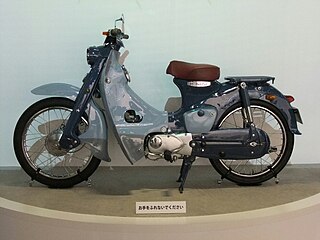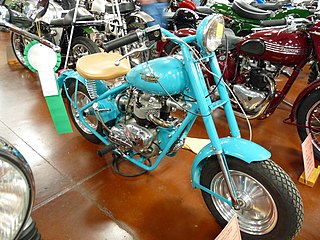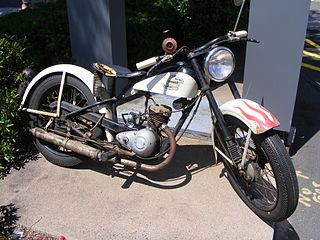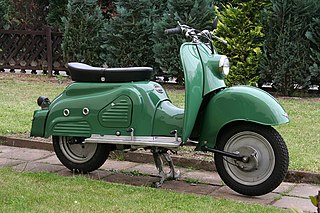Related Research Articles

A motorcycle, often called a motorbike, bike, or cycle, is a two- or three-wheeled motor vehicle. Motorcycle design varies greatly to suit a range of different purposes: long-distance travel, commuting, cruising, sport, and off-road riding. Motorcycling is riding a motorcycle and being involved in other related social activity such as joining a motorcycle club and attending motorcycle rallies.

A flat-twin engine is a two-cylinder internal combustion engine with the cylinders on opposite sides of the crankshaft. The most common type of flat-twin engine is the boxer-twin engine, where both cylinders move inwards and outwards at the same time.

A custom motorcycle is a motorcycle with stylistic and/or structural changes to the 'standard' mass-produced machine offered by major manufacturers. Custom motorcycles might be unique, or built in limited quantities. While individual motorcyclists have altered the appearance of their machines since the very first days of motorcycling, the first individualized motorcycles specifically labeled 'Custom' appeared in the late 1950s, around the same time as the term was applied to custom cars. In the 1960s, custom artisans like Arlen Ness and Ben Hardy created new styles of custom bikes, the chopper. In the 1990s and early 2000s, very expensive customs such as those built by Orange County Choppers, Jesse James's West Coast Choppers, Roger Goldammer became fashionable status symbols. There are also companies that are bringing back pin striping, such as Kenny Howard and Dean Jeffries from the 1950s, with a continued effort to keep pin striping alive. The choppers of the 1960s and 1970s fit into this category.

A sportbike, or sports bike, is a motorcycle optimized for speed, acceleration, braking, and cornering on paved roads, typically at the expense of comfort and fuel economy by comparison with other motorcycles. Soichiro Honda wrote in the owner's manual of the 1959 Honda CB92 Benly Super Sport that, "Primarily, essentials of the motorcycle consists in the speed and the thrill," while Cycle World's Kevin Cameron says that, "A sportbike is a motorcycle whose enjoyment consists mainly from its ability to perform on all types of paved highway – its cornering ability, its handling, its thrilling acceleration and braking power, even its speed."

The Honda Super Cub or Honda Cub is a Honda underbone motorcycle with a four-stroke single-cylinder engine ranging in displacement from 49 to 124 cc.

A motorcycle engine is an engine that powers a motorcycle. Motorcycle engines are typically two-stroke or four-stroke internal combustion engines, but other engine types, such as Wankels and electric motors, have been used.

The Ner-A-Car was a type of feet forwards motorcycle designed by Carl Neracher in 1918. It used an unusual steel-channel chassis, much like an automobile, and hub-center steering at the front wheel, making it 'nearly a car' in design. The Ner-A-Car was the most successful hub-center steering motorcycle ever produced, with sales far eclipsing earlier or later examples of this design, such as the Yamaha GTS1000 or Bimota Tesi. About 10,000 Neracars were manufactured in the United States by the Ner-A-Car Corporation, while around 6,500 are believed to have been produced in England under licence by the Sheffield-Simplex company between 1921 and 1926 under the Ner-A-Car name.

The Mustang was a lightweight motorcycle built by Gladden Products Corporation in Glendale, California, from 1946 to 1965. The second production version, the Mustang Model 2, was among the first motorcycle manufactured in the United States to have a telescopic fork.

The Harley-Davidson XA was a flat-twin, shaft drive motorcycle made by Harley-Davidson for the US Army during World War II.

The Hummer was a motorcycle model manufactured by Harley-Davidson from 1955 to 1959. However, the name "Hummer" is now incorrectly used generically to refer to all American-made single-cylinder two-stroke Harley-Davidson motorcycles manufactured from 1948 to 1966. These motorcycles were based on the DKW RT125, the drawings for which were taken from Germany as war reparations after World War II. The RT125 drawings were also given to the United Kingdom and the Soviet Union as war reparations, resulting in the BSA Bantam and the MMZ M-1A Moskva, later known as the Minsk.

Berliner Motor Corporation was the US distributor from the 1950s through the 1980s for several European motorcycle marques, including Ducati, J-Be, Matchless, Moto Guzzi, Norton, Sachs and Zündapp, as well as selling Metzeler tires. Berliner Motor was highly influential as the voice of the huge American market to the motorcycle companies they bought bikes from, and their suggestions, and sometimes forceful demands, guided many decisions in Europe as to which bikes to develop, produce, or discontinue.
Joe Berliner [...] a man endowed with great decision-making power in Borgo Panigale

A scooter or motor scooter is a motorcycle with a step-through frame and a platform for the rider's feet. Elements of scooter design were present in some of the earliest motorcycles, and scooters have been made since at least 1914. Scooter development continued in Europe and the United States between the World Wars.
Charles Bayly Franklin was an engineer and a motorcycle racer. He designed motorcycles for the Indian Motocycle Company, including the original Indian Scout of 1920, the original Indian Chief of 1922, and the Indian 101 Scout of 1928. Prior to this, he had been part of the Indian motorcycle team that won first, second, and third place in the 1911 Isle of Man TT, finishing in second place. Franklin was inducted into the AMA Motorcycle Hall of Fame in 2016.

Motorcycle testing and measurement includes a range of more than two dozen statistics giving the specifications of the motorcycle, and the actual performance, expressed by such things as the output of the engine, and the top speed or acceleration of the motorcycle. Most parameters are uncontroversial and claims made by manufacturers are generally accepted without verification. These might include simple measurements like rake, trail, or wheelbase, or basic features, such as the type of brakes or ignition system.

Simplex Manufacturing Corporation was an American manufacturer that made motorcycles from 1935 to 1975. Between 1935 and 1960, Simplex made variations of the Simplex Servi-Cycle including the 1953–1960 Simplex Automatic. Simplex was the only motorcycle manufacturer located in the Deep South for many years, until Confederate Motorcycles began production.

The following outline is provided as an overview of motorcycles and motorcycling:

The Daimler Reitwagen or Einspur was a motor vehicle made by Gottlieb Daimler and Wilhelm Maybach in 1885. It is widely recognized as the first motorcycle. Daimler is often called "the father of the motorcycle" for this invention. Even when the steam powered two-wheelers that preceded the Reitwagen, the Michaux-Perreaux and Roper of 1867–1869, and the 1884 Copeland, are considered motorcycles, it remains nonetheless the first gasoline internal combustion motorcycle, and the forerunner of all vehicles, land, sea and air, that use its overwhelmingly popular engine type.

Lambretta is the brand name of mainly motor scooters, initially manufactured in Milan, Italy, by Innocenti.

The Cleveland Motorcycle Manufacturing Company, sometimes called Cleveland Motorcycle, was a motorcycle manufacturer in Cleveland, Ohio, from 1902 to 1905 and again from 1915 to 1929.

The Zündapp Bella is a motor scooter manufactured by motorcycle manufacturer Zündapp from 1953 to 1964. Approximately 130,000 Bella scooters were sold, with engine sizes ranging from 150 cc to 200 cc.
References
- Arctander, Erik H. (June 1959). Allaway, Howard (ed.). "New U.S. Scooter Shifts for Itself". Popular Science. Popular Science Publishing. 174 (6): 64–65. ISSN 0161-7370 . Retrieved 2012-07-25.
- Dan, Michael (2007-05-01). The A-Z of Popular Scooters & Microcars: Cruising in Style!. MBI Publishing. p. 138. ISBN 978-1-84584-088-4.
The enclosed engine did not have a cooling fan which, on occasion, led to overheating problems.
- Hicks, Clifford B., ed. (April 1961). "More power to you! on the new Harley-Davidson Topper H motor scooter". Popular Mechanics . 115 (4): 229. ISSN 0032-4558 . Retrieved 2012-09-02.
A 5-hp Model "U" Topper is also available to comply with junior licensing laws in some states.
- Ismon, Alton, ed. (November 1959a). "1960 Harley-Davidsons". American Motorcyclist. Westerville, OH USA: American Motorcyclist Association. 13 (11): 12–14. ISSN 0277-9358 . Retrieved 2012-07-25.
- Ismon, Alton, ed. (December 1959b). "Topper Makes Test Run at Death Valley". American Motorcyclist. Westerville, OH USA: American Motorcyclist Association. 13 (12): 35. ISSN 0277-9358 . Retrieved 2012-09-02.
- Ismon, Alton, ed. (May 1961). "Topper H Sports Improved Features". American Motorcyclist. Westerville, OH USA: American Motorcyclist Association. 15 (5): 18. ISSN 0277-9358 . Retrieved 2012-09-02.
- Ismon, Alton, ed. (November 1962). "'63 Harley-Davidsons". American Motorcyclist. Westerville, OH USA: American Motorcyclist Association. 16 (11): 12–13. ISSN 0277-9358 . Retrieved 2012-09-02.
- Wood, Bill, ed. (October 2004). "1960 H-D Topper: Milwaukee goes scootering". Museum Classic. American Motorcyclist (Members' magazine). Pickerington, OH US: American Motorcyclist Association. 58 (10): 67. ISSN 0277-9358 . Retrieved 2015-04-19.
- Wright, David K. (1987) [1983]. "Chapter Three: Iron". The Harley-Davidson Motor Company: An Official Eighty-Year History (Second ed.). Motorbooks International. pp. 46–97. ISBN 0-87938-245-7.
William H. Davidson told directors that 10,000 were made and sold in the first seven months of 1947.
- Online
- "Harley-Davidson Timeline 1960s". Harley-Davidson Timeline. Harley-Davidson. 2015. Archived from the original on 2006-10-29. Retrieved 2015-04-19.
The Harley-Davidson Topper motor scooter is introduced and is the only scooter platform the Motor Company ever produced.
- The Auto Editors of Consumer Guide (2007-09-18). "1963 Harley-Davidson Topper". How Stuff Works. Archived from the original on 2009-12-03. Retrieved 2015-04-19.
Its 165-cc two-stroke single was started with a recoil starter, like a lawn mower, and drove through a variable-ratio automatic transmission called Scootaway Drive.
- "Lambretta Model E". Lambretta Club of Great Britain. Archived from the original on 2010-06-23. Retrieved 2012-12-24.
To start the scooter a pull cord (like that found on chain saws) was mounted in front of the magneto, the ignition on the E could be advanced and retarded for ease of staring (sic) on the pull cord, this ensured the machine did not 'kick back' injuring the person while starting it.